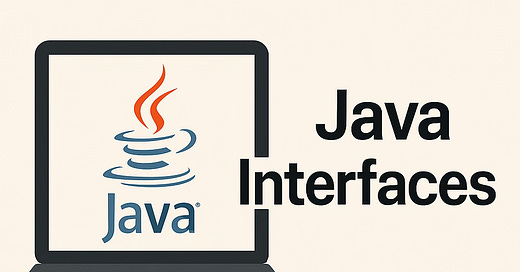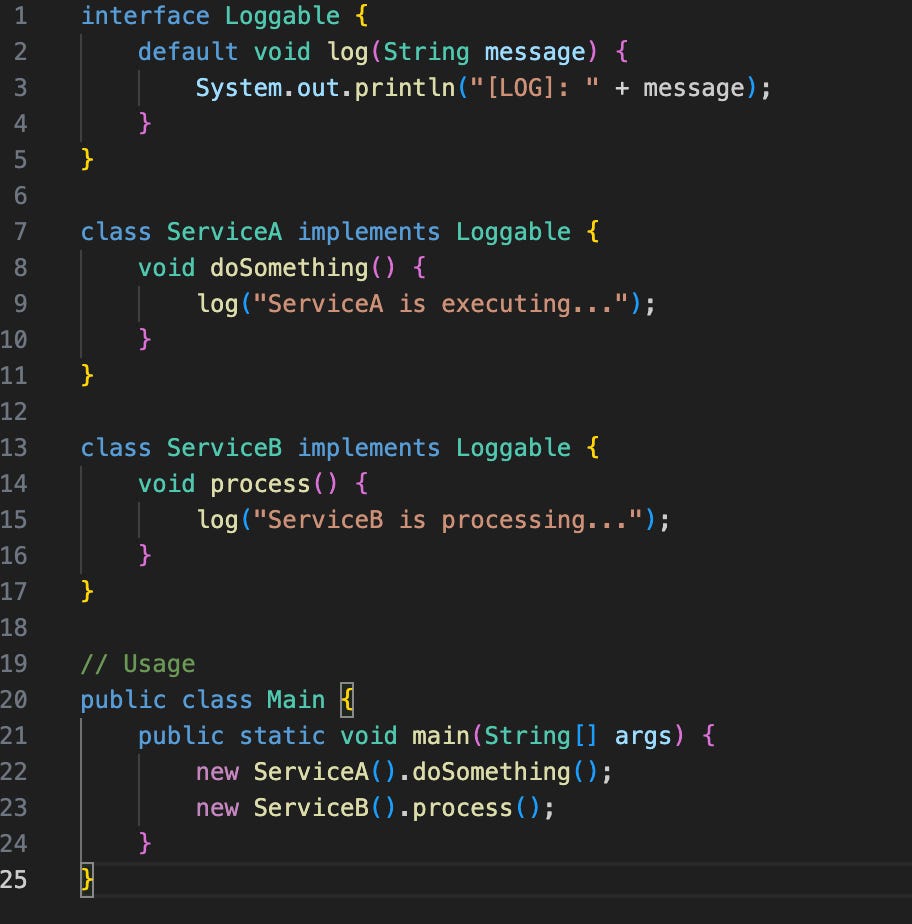How to Use Java Interfaces Like a Pro
Unconventional but Effective Ways to Use Interfaces in Java
Java devs usually stick to the usual stuff-inheritance, abstract classes, and direct object creation-to structure their code. It works, but sometimes it can make things more rigid or more complex than needed.
In this post, I’ll walk through some less common but super useful ways to use interfaces in Java. They’re not meant to replace the old ways, but in the right situations, they can make your code cleaner and way more flexible.
Interface-Based Configuration (An Upgrade to Strategy Pattern)
Instead of relying on config files or enums to drive dynamic behavior, you can use interfaces to directly represent and encapsulate different behaviors.
When to Use:
When you need to switch behavior dynamically - like choosing between different caching strategies - based on config or environment.
Problems with Traditional Approaches (Configs / Enums):
Usually involves parsing properties, YAML, or JSON.
Enums need switch-case logic to select behavior.
Adds boilerplate and can become messy over time.
Why Interfaces Are Better Here:
You model behavior, not just config values.
Cleaner: no more switch statements or lookup logic.
Flexible: swap implementations at runtime easily.
Test-friendly: inject mock/stub configurations as needed.
Interface for Method Chaining with Conditions
You can use interfaces to build method chains where some methods are only called if certain conditions are met. This makes your fluent APIs more flexible and expressive.
When to Use:
When you're designing a fluent-style API and want to skip certain method calls based on conditions.
Why It’s Useful:
Makes code easier to read and follow.
Skips unnecessary method calls if a condition doesn’t apply.
Keeps your chaining logic clean and intention-focused.
Traditional Alternative for this
if (conditionMet) {
obj.doSomething();
obj.doAnotherThing();
}Why Interface-Based Chaining is Better?
More expressive and readable (avoids deep nesting).
Fluent interface makes chaining intuitive.
Prevents unnecessary method calls by skipping calls dynamically.
Marker Interfaces for Type Tagging
Marker interfaces are empty interfaces - no methods, just a way to "tag" classes. They’re super useful when you want to treat certain classes differently at runtime.
Why Use Them:
Add metadata without adding any extra fields or logic.
Use
instanceofto check if an object is "tagged" with a certain type.Helps you apply special behavior only to specific classes.
When to Use:
When you need a lightweight way to differentiate types or apply conditional logic based on class type-without cluttering your code.
Advantages over using Boolean Flags or Annotations:
No runtime overhead (annotations require reflection).
Cannot be altered accidentally (boolean flags can be changed at runtime).
Type safety : classes implementing the marker interface can be enforced by compiler checks.
Interface Inheritance Tricks for Default Behavior
You can extend interfaces and use default methods to share common logic across multiple classes - even if they’re totally unrelated.
When to Use:
When you want to reuse behavior without relying on abstract base classes or tight inheritance.
Why It’s Useful:
Lets you define shared logic in one place.
Avoids forcing a class hierarchy just for behavior reuse.
Works great for utility-style behaviors across unrelated types.
Benefits over abstract class
Allows multiple inheritance of behaviour (abstract classes do not).
Doesn’t force class hierarchy (a class can implement multiple interfaces but extend only one class).
More modular - easy to introduce new behaviors without modifying existing code.
Interface Inheritance for API Versioning
You can version your APIs by chaining interfaces - like ApiV1, then ApiV2 extends ApiV1, and so on. Each version builds on the previous one, adding or updating methods as needed.
When to Use:
When your API evolves over time, and you want to keep older versions working while adding new features.
Why It’s Useful:
Keeps things backward-compatible.
Old clients can still use
ApiV1, new ones getApiV2.One implementation can support all versions by just implementing the latest interface.
This avoids breaking changes in APIs, allows gradual adoption of new features, and keeps the codebase clean by leveraging polymorphism. It’s more explicit than maintaining separate classes or method overloads.
Use this in systems with long-lived APIs (e.g., libraries or microservices) where you need to support multiple client versions without duplicating code.
Functional Interface Chaining (Pipeline Pattern)
You can chain functional interfaces together to build a processing pipeline, each step takes input from the previous one and passes output to the next.
When to Use:
Great for stream processing, event handling, or ETL pipelines where you want to plug operations together dynamically.
Why It’s Useful:
Breaks complex logic into small, reusable pieces.
Easy to compose workflows using lambdas.
Keeps the code clean, modular, and testable.
This promotes modularity, testability, and readability in data-processing or event-handling systems. It’s an alternative to bulky class hierarchies or monolithic method chains.
Interfaces in Java are more than just method contracts. When used creatively, they can simplify design, improve flexibility, and reduce boilerplate.
This isn’t about replacing traditional approaches- just expanding your toolkit.
Next time you're solving a design problem, pause and ask: Can an interface do this better?










